The term atmosphere originated from the Ancient Greek words atmos, which means water vapor, and sphaira, which means sphere or ball. Currently, this term is used to describe the gas envelope that surrounds the Earth.
The atmosphere is composed of a mechanical mixture of various gases. In a sample of clean and dry air, approximately 78% (by volume) is nitrogen, 21% is oxygen, and around 1% is argon. Additionally, it contains approximately 0.03% carbon dioxide.
Nitrogen, oxygen, argon, and carbon dioxide account for 99.99% of dry and clean air. The remaining 0.01% consists of trace amounts of gases such as neon, krypton, helium, ozone, xenon, and hydrogen. However, these gases are present in such insignificant quantities that they have no practical significance in the study of weather phenomena.
The level of carbon dioxide is not completely stable. It is consistently absorbed by plants and continuously produced by animals, as well as being created through the combustion of fuel, volcanic activity, and decomposition in the soil. While these processes are not always in perfect balance, the overall amount of carbon dioxide in the atmosphere remains relatively constant due to the effective regulation of its quantity by the oceans, which dissolve any excess.
The quantity of ozone in the lower atmosphere is relatively small. It reaches its peak at altitudes between 10 and 25 km, where it experiences significant fluctuations in concentration.
Aside from these fluctuations in carbon dioxide and ozone levels, the composition of the atmosphere remains remarkably consistent both in its distribution across the Earth’s surface and in its vertical profile, at least within the range detectable by instruments.
Water vapor is also present in the air in varying amounts, making it an important component of the atmosphere.
The quantity of water vapor in the air is dependent on its temperature. As the temperature rises, the air is capable of holding more water vapor. When the amount of water vapor in the air reaches its maximum capacity at a certain temperature, the air is considered saturated. If the air cools below the saturation temperature, condensation occurs, causing water vapor bubbles to transform into water droplets or ice crystals if the temperature drops below freezing.
The tiny water droplets and crystals are maintained in the atmosphere by ascending air currents. In specific circumstances, as explained later, these minuscule droplets or ice crystals merge together to create substantial drops or flakes of snow. Once they grow to a size that exceeds the capacity of the upward currents to sustain them airborne, they descend as rain or snow.
Impurities
In addition to the mentioned components, air also contains a varying quantity of impurities. These impurities consist of dust, soot, and salt.
Arid regions such as deserts and steppes are the primary sources of dust. Larger particles carried by winds do not travel far from their origin, but fine dust particles can travel long distances and become dispersed throughout the lower atmosphere. Air masses that have passed over subtropical continents often contain significant amounts of dust. Polar air masses are generally free of dust.
Industrial zones, active volcanoes, and occasional forest fires are major sources of soot. When fuel is burned at high temperatures, hydrogen and oxygen combine to create water vapor, while carbon and oxygen combine to form carbon dioxide, both of which are normal components of the atmosphere.
If the fuel is burned at a low temperature, it hinders the combination of carbon and oxygen, causing the partially burned coal particles to be lifted by the rising air and condensed into soot.
Studies show that the air often contains significant amounts of salt. When the wind blows, the ocean surface spray is lifted into the air; as the water evaporates, tiny salt particles are left behind.
The tiny particles that contaminate the air and cause it to become hazy are so minuscule that they cannot be seen with the naked eye, but the resulting reduction in visibility and alteration of the appearance of faraway objects is easily noticeable. Distant objects, particularly dark ones like mountains, become visible as if seen through a thin, light blue veil. If the objects are white, such as snow-covered mountains or clouds near the horizon, the veil takes on a yellowish hue. As the level of cloudiness increases, all intricate details vanish at a certain distance, leaving only the outlines of the objects against the backdrop of the sky. The greater the haziness, the closer the point at which the object’s details completely vanish.
The existence of dust in the atmosphere not only impacts the visibility of objects: if there were no dust in the air, it would be completely clear and there would be no noticeable condensation of water vapor. The latter phenomenon occurs when the air cools down to the saturation temperature on specific active (hygroscopic) nuclei. The most active nuclei for condensation are salt particles from the oceans and combustion byproducts. Observations indicate that these particles are consistently present in significant quantities in the atmosphere.
Structure of the Atmosphere
The atmosphere is characterized by its mobility and compressibility. Despite being lightweight, it still possesses a certain amount of weight. Under normal pressure and temperature conditions, the weight of a given volume of air at the Earth’s surface is approximately 1/800th of the weight of the same volume of water. Specifically, one cubic meter of air weighs around 1.3 kilograms.
A vertical column of air extending from the Earth’s surface to the atmospheric boundary exerts pressure on the Earth’s surface that is equivalent to the weight of a column of water measuring approximately 10 meters in height, or the weight of a column of mercury measuring only 76 centimeters in height. Thus, mercury barometers are utilized to measure atmospheric pressure.
As altitude increases, atmospheric pressure decreases. By measuring the weight of an air column between two points on a vertical line and knowing the temperature and pressure at those points, we can determine the difference in altitude between them. When the temperature follows a normal distribution, pressure becomes a straightforward function of altitude. This relationship enabled the development of specialized barometers called altimeters, which directly indicate altitude on their scale instead of pressure. Nowadays, these instruments are extensively utilized in the field of aviation.
As altitude increases, atmospheric pressure gradually decreases and approaches zero due to the weight of the air column. The density of the air also undergoes changes. However, it is important to note that the atmosphere does not have a distinct upper boundary, but instead gradually transitions into airless space.
While the atmosphere extends to great heights, it is primarily the lower part that influences weather patterns. The highest clouds are rarely observed above 10 km above the Earth’s surface. Approximately 50% of the total weight of the atmosphere and around 90% of its moisture content are concentrated within the lower 5 km.
Atmospheric Stratification
The atmosphere is divided into different layers based on the temperature variation with altitude. It has been observed that the temperature decreases as we ascend up to 11 km, after which it remains relatively constant. This change in temperature with altitude is known as the vertical temperature gradient.
The lower region of the atmosphere, where there is a significant temperature gradient, is known as the troposphere. This is the layer closest to the Earth’s surface and is where weather phenomena occur. The upper part of the atmosphere, where the temperature remains almost constant, is called the stratosphere. The transition zone that separates the stratosphere from the troposphere is known as the tropopause.
The altitude of the tropopause above the surface of the Earth varies depending on the latitude and time of year. Additionally, it is influenced by weather patterns, with the tropopause typically located at a lower altitude over low-pressure areas (cyclones) and at a higher altitude over high-pressure areas (anticyclones). Fig. 2 depicts the typical altitude of the tropopause and the average temperature distribution in the lower atmosphere. It is worth noting that the temperature in the stratosphere decreases as one moves from the poles towards the equator.
The maximum altitude reached by meteorological instruments is around 36 km. The most recent research on radiation, meteors, auroras, sound propagation, and radio waves, among other things, provides us with valuable information about the composition of the upper atmosphere. Based on these observations, we can summarize our current understanding of atmospheric stratification as follows.
In the troposphere, there is a decrease in temperature of approximately 0.6 degrees for every 100 m increase in altitude. The troposphere is relatively unstable, often giving rise to vertical currents that result in the condensation of water vapor and the formation of clouds and precipitation. All typical weather phenomena occur within the troposphere, primarily in its lower half.
At altitudes above the tropopause, the temperature remains constant or even increases. This phenomenon has been observed by meteorological instruments. Furthermore, this region is characterized by a high concentration of ozone, as discovered in recent studies conducted by Dobson and others. Interestingly, the amount of ozone above the tropopause has been found to have a significant impact on the Earth’s surface weather. Unlike the troposphere, the stratosphere is typically devoid of clouds. However, there are instances where a unique type of cloud, known as nacre clouds, can form due to the presence of ozone. The space between the tropopause and the ozone layer is consistently cloudless, and the stability of the air within this layer makes it an ideal environment for flying in the lower stratosphere.
According to statistical research, meteors primarily vanish at an elevation ranging from 40 to 80 kilometers above the surface of the Earth. This observation, along with findings from sound wave investigations, suggests that the temperature within the layer situated between 40 and 80 kilometers is exceptionally warm, ranging from 60 to 70 degrees Celsius.
Furthermore, at approximately 60 km above ground level, there exists a stratum that possesses a propensity to absorb radio waves. As this layer forms due to the influence of sunlight, the coverage range of radio stations, particularly those operating on shortwave frequencies, expands during nighttime hours.
Above 80 km is the ionosphere, which is also known as the ionized layer of the Earth’s atmosphere. Occasionally, there are luminous clouds present in the lower part of the ionosphere. The ionosphere consists of multiple electrically conductive layers, with the most significant one being the Kemielly-Heaviside layer, also referred to as the £-layer. This particular layer has the ability to reflect radio waves back to the surface of the Earth, which is why radio stations have such a long range. The Cannelli-Heaviside layer is distinct and typically found at altitudes between 90 and 130 km under normal conditions. Above the Cannelli-Heaviside layer is the Appleton layer, also known as the F-layer. The Appleton layer is weaker and its altitude can vary, sometimes breaking up into multiple indistinct layers.
Auroras, along with other similar occurrences, are frequently spotted in the lower region of the ionosphere. Recent investigations conducted by Stormer have provided evidence that auroras can be observed as high as 1200 km above the surface of the Earth. This discovery serves as an indication that there is a measurable amount of atmosphere even at these elevated heights.

This lesson marks the beginning of the exploration into the subject of “Atmosphere”. It provides an understanding of the composition of the Earth’s atmospheric layer, its significance, and methods of investigation. Additionally, this lesson introduces the notions of atmosphere, troposphere, stratosphere, ozone layer, and upper atmosphere.
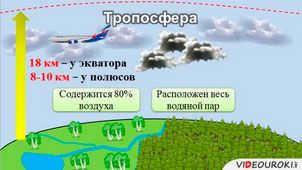
Currently, there is a restriction on viewing or sharing the video lesson with students
In order to watch this and other video lessons included in the package, you will have to add it to your personal account.
Unlock amazing possibilities


Outline of the lesson “Atmosphere: structure, importance, study”
On Earth, there are several distinct shells: lithosphere, hydrosphere, atmosphere, biosphere.
Today, you will become acquainted with the atmosphere – the Earth’s airy envelope. It encompasses the entire surface of the planet. The thickness of the atmosphere is 3000 kilometers.. The lower layer of the atmosphere is considered to be the Earth’s surface, while the upper layer has no upper boundary – it gradually transitions into outer space.
The air near the planet’s surface is held in place by its gravitational force, and the constant movement of its particles prevents them from falling.
What is air composed of?
The atmosphere is a combination of diverse gases, particulate matter, dust, and soot. It is primarily composed of nitrogen at 78% and oxygen at 21%, while the remaining gases include argon at 0.93% and carbon dioxide at 0.03%, along with helium, hydrogen, ozone, and other gases. Due to the variations in its composition, temperature, and density at different altitudes, the atmosphere can be divided into multiple layers.

The initial layer is known as the troposphere, which expands until reaching an altitude of 18 kilometers. This is the maximum thickness of the troposphere at the equator, while at the polar regions it measures between 8 to 10 kilometers. Comprising up to 80% of the atmosphere, this layer is also where water vapor is found. The troposphere is where rainfall occurs and where aircraft and wind operate. Heating originates from the Earth’s surface, resulting in a gradual decrease in temperature as we ascend, with an average drop of 10 degrees Celsius per 1 kilometer of altitude.

The layer above the troposphere is known as the stratosphere. In the stratosphere, there is a significantly lower amount of air compared to the troposphere. While the air temperature generally decreases as you go higher, at altitudes of 20 to 30 kilometers, it actually starts to gradually increase. This is due to the presence of the ozone layer in this region.

The ozone layer plays an incredibly important role for all life on Earth. It acts as a shield, protecting us from the harmful ultraviolet rays that would otherwise reach the surface of our planet. If we were able to gather all the ozone near the Earth’s surface, it would only measure 0.25 centimeters in thickness. Yes, you read that correctly – a mere 0.25 centimeters. In fact, the sky would appear almost black at this altitude. This is because the gas molecules in the air scatter the shorter blue, blue-green, and violet wavelengths of light, giving the sky its characteristic blue color. This phenomenon is known as Rayleigh scattering, and it is the reason why we perceive a blue sky from the Earth’s surface.
However, as we ascend above our planet, the density of the atmosphere decreases, and the color of the sky deepens. In the stratosphere, the sky takes on a darker, more intense shade of blue, almost appearing black and purple in certain areas. The upper region of the stratosphere can be found at an altitude of 50 kilometers.
The upper layers of the atmosphere consist of the mesosphere, thermosphere, and exosphere.

The mesosphere stretches up to 80 kilometers in height. This region is extremely cold, with temperatures dropping as low as -90 degrees Celsius. However, in the subsequent layer of the atmosphere, namely the thermosphere, temperatures rise again and can reach 1500 0 С. It is in this layer that we can witness the mesmerizing phenomenon of polar lights.
These dazzling lights are also observable in the next layer of the atmosphere – the exosphere, which is situated at an altitude above 400 kilometers. This layer gradually extends into outer space.
The atmosphere of the Earth plays a vital role in safeguarding the surface of our planet from meteorites that enter the Earth’s atmosphere at high speeds due to the gravitational pull. These meteorites, upon encountering the air, experience friction and are mostly incinerated.
Nevertheless, there are instances when these celestial objects manage to penetrate our planet without completely disintegrating in the atmosphere. One such incident occurred on February 15, 2013, in the vicinity of Chelyabinsk. The impact resulted in atmospheric explosions not only in Chelyabinsk but also in other parts of Russia.

The Earth’s atmospheric layer regulates the planet’s heat distribution. It captures and retains half of the heat that is accumulated near the Earth’s surface. As a result, the Earth experiences a balanced temperature throughout, avoiding extreme variations between the poles and the equator.
Oxygen is an essential component of the Earth’s atmosphere, supporting all forms of life on the planet. Each minute, an individual inhales approximately 5 to 10 liters of air. While humans can survive for several weeks without food and up to 8 days without water, it is impossible to live without air even for a single minute.
The atmosphere also serves as a primary source of nitrogen, a crucial element that forms the basis of proteins – the fundamental building blocks of our bodies.
The air envelope is an ecosystem where sound travels. Air is essential for sound propagation on Earth. Without an atmosphere, our planet would be devoid of sound and life as we know it would be vastly different.
Regrettably, humans often overlook this fact and contribute to air pollution through the release of harmful substances such as soot, dust, and carbon dioxide. Such polluted air has been linked to increased rates of illness in humans. It is crucial for individuals to remember the importance of clean air. This can be achieved by reducing the emission of pollutants into the atmosphere and increasing the presence of green spaces.
Throughout history, humans have been curious about the happenings within the air envelope as their activities rely on it.
Currently, the World Meteorological Organization, of which Russia is a member, is conducting research on the atmosphere. Meteorological services are operational in almost every part of the globe. Their staff members collect data from meteorological instruments every 3 hours, enabling accurate weather predictions.

Contemporary weather satellites, exploration devices, and balloons. Weather satellites, exploration devices, balloons, rockets. To examine the density of the atmosphere, for instance, they utilize special balloons that are equipped with radiosondes. These radiosondes transmit all information regarding atmospheric processes occurring at high altitude back to the Earth’s surface. When it becomes necessary to gather data about the state of the atmosphere at extremely high altitudes, weather rockets are employed. Meteorological rockets. Moreover, with the aid of artificial satellites, humans can monitor upper atmospheric conditions and make weather forecasts.

The Earth’s air envelope is known as the atmosphere. It is approximately 3000 kilometers thick. The atmosphere comprises a mixture of gases collectively referred to as air.
The composition of atmospheric air is as follows: 78% nitrogen, 21% oxygen, 0.93% argon, 0.03% carbon dioxide, and other trace gases. The Earth’s air envelope is characterized by a diverse structure, which includes the troposphere, stratosphere, mesosphere, thermosphere, and exosphere.
The troposphere, which is the lowest layer of the atmosphere, extends up to a height of 18 kilometers. It contains approximately 80% of the total air mass and exhibits a decrease in both precipitation and temperature with increasing altitude, with a decrease of 6 degrees Celsius per kilometer.
In the stratosphere, there is the ozone layer that shields all living beings on the planet from the Sun’s harmful ultraviolet radiation. Beyond the stratosphere lie the higher regions of the atmosphere: mesosphere, thermosphere, and exosphere. These layers contain extremely thin air. Consequently, the uppermost layers of the atmosphere gradually merge into outer space.
The significance of Earth’s air envelope cannot be overstated: it shields all life on the planet from dangerous ultraviolet radiation, safeguards against meteorite impacts, and regulates the planet’s temperature, preventing both excessive cooling and overheating.
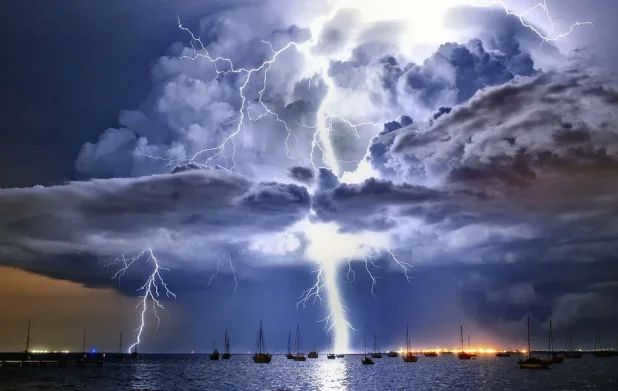
Throughout our lives, we have all experienced a wide range of natural phenomena. It is incredibly fascinating to observe the snow or rain falling from our windows. Equally thrilling is the act of climbing snowdrifts or jumping into puddles. Whenever we venture outdoors, we instinctively glance out the window to gauge the weather conditions. Our daily lives are intricately intertwined with the natural phenomena present in the atmosphere. In this lesson, we will explore the composition of the Earth’s gaseous envelope. We will uncover the mechanisms behind the heating of the Earth’s surface and the correlation between air temperature and geographic latitude. Additionally, we will delve into the concept of precipitation and its various forms.
The Composition and Structure of the Atmosphere
The atmosphere of planet Earth is a gas envelope that extends up to 1000 km. It is like an ocean of gas, in which our existence is confined to the bottom.
So, what is the atmosphere made of? This shell is a mixture of gases known as air, but it also contains various other substances.
The structure of the atmosphere is not uniform, and it can be divided into several layers. Let’s take a closer look at them in the diagram below.
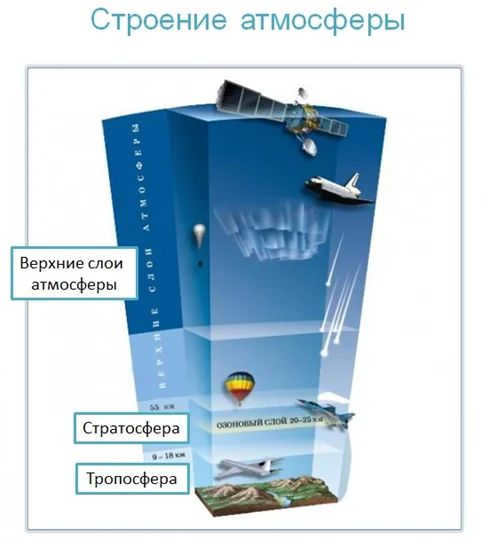
The troposphere, a layer near the Earth’s surface, is approximately 10-11 km high on average and can reach up to 17 km at the equator. Comprising 80% of the total atmospheric air, the troposphere is composed of nitrogen, oxygen, carbon dioxide, and various other substances.
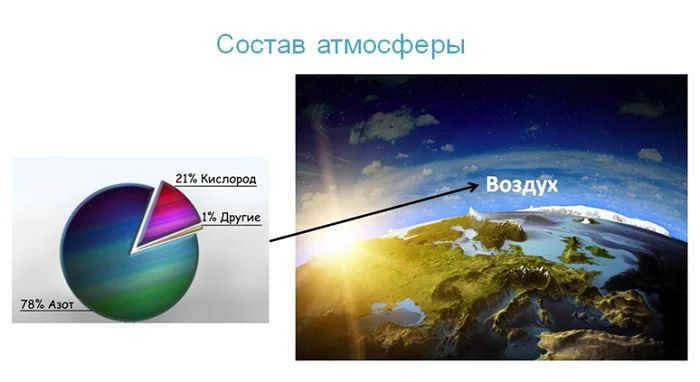
Primarily, the atmosphere is composed of nitrogen, which plays a vital role in the existence of all organisms. Nitrogen constitutes proteins, which serve as the foundation for every living creature. Its compounds are essential for the nourishment of plants.
Oxygen is another gas present in the air. Its significance surpasses that of nitrogen. It is well-known that all living beings utilize oxygen for respiration. Simultaneously, the deficiency of oxygen in the atmospheric envelope is regularly replenished by plants, which consume carbon dioxide and convert it into oxygen.
Carbon dioxide can be likened to the Earth’s “insulator” as it allows solar energy to enter but traps heat.
The atmosphere primarily consists of these two gases, although there are numerous other substances as well.
Solid particles are present as a result of fires and volcanic eruptions.
The presence of water vapor in the lower layers of the atmosphere leads to the formation of various precipitates.
What is fascinating is that the temperature of the air in the troposphere changes with altitude. As one goes higher, the temperature decreases and it gets colder.
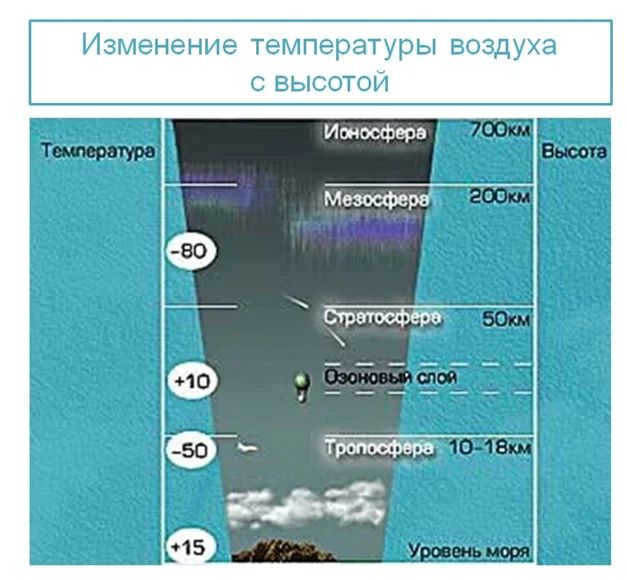
What is the reason for the temperature change in the troposphere as you go higher? This change occurs because the air in the lower layers receives more heat from the Earth’s surface, which is heated by the Sun. The Sun’s radiation passes through the troposphere without heating it, and the Earth’s surface cannot heat the entire layer. As a result, the temperature in the troposphere decreases with altitude, and it can reach -50 0 C at the top.
Above the troposphere, there is the next layer called the stratosphere, which extends to 50-60km. In the middle layer of the atmosphere, known as the stratosphere, there is very little water vapor and almost no cloud formation.
The temperature variation in the stratosphere also differs. At 20 km altitude, the lowest temperature of -60 0 C is observed, but it increases starting from 25 km and can reach up to +10 0 C.
This increase in temperature can be attributed to the absorption of solar radiation by ozone, which constitutes up to 60% of this layer. Ozone is created from oxygen through the interaction of sunlight and electrical discharges. It forms the ozone layer in the stratosphere above our planet. This layer absorbs ultraviolet rays from the Sun, which can be highly damaging to living organisms.
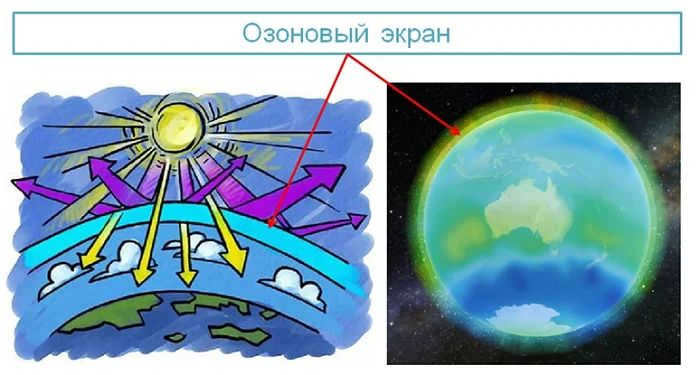
The troposphere is widely researched, but there is growing interest in the stratosphere and the layers above it. Artificial satellites and spacecraft provide scientists with valuable data on these regions. In 2012, an exceptional leap was made from the stratosphere.
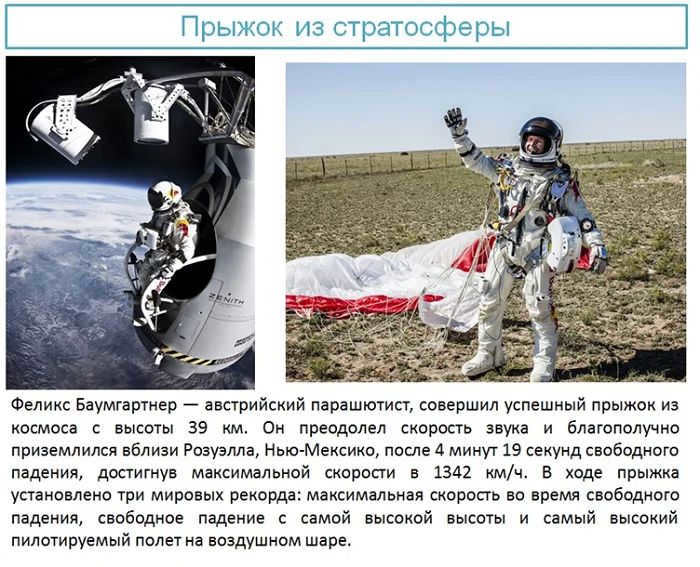
There are several layers above the stratosphere. Here, clouds composed of ice crystals are formed, creating a silver appearance. Additionally, one can witness the mesmerizing aurora borealis and occasionally experience magnetic storms.
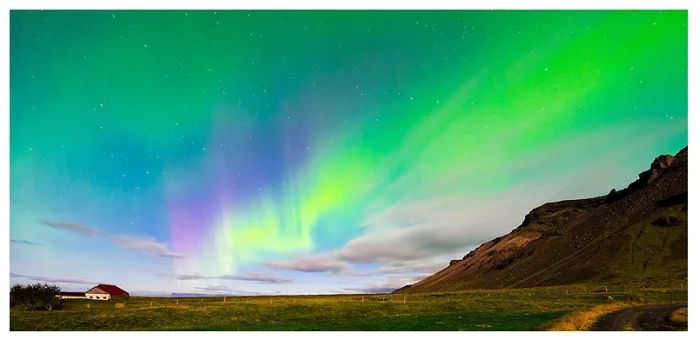
The phenomenon of the Northern Lights on the Icelandic island
Heating of the atmosphere and its temperature
The primary source of warmth on our planet is the energy emitted by the Sun, which is absorbed by the Earth and subsequently warms the air.
Once within the atmospheric layer, a portion of this heat is absorbed, some is dissipated, and the remaining portion is reflected by the Earth’s surface and clouds.
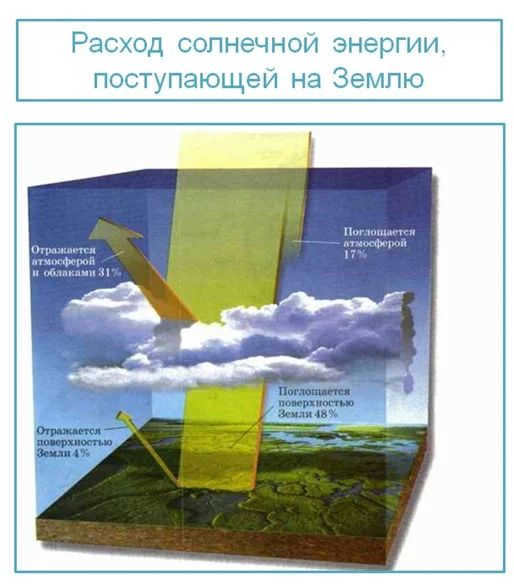
The warming of the air in the atmosphere is derived from the planet’s surface. The presence of low clouds hinders the radiation emitted by the Earth, preventing it from dissipating and ultimately leading to the heating of the air. Conversely, a clear sky allows for strong radiation, which warms a substantial amount of air. There are numerous factors that influence air temperature, and in the following paragraphs, we will examine the most significant ones.
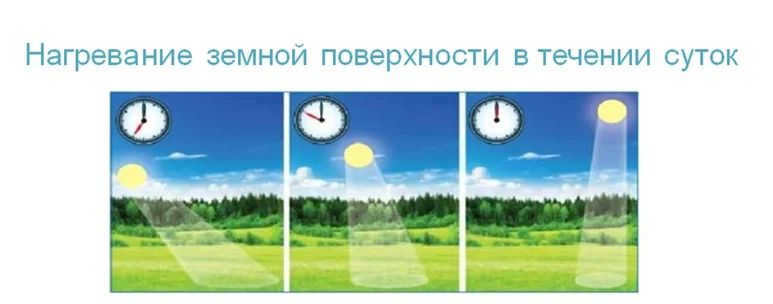
During the course of the day, there are significant fluctuations in temperature due to the heating and cooling of the air, which is influenced by the angle at which sunlight hits the Earth’s surface. When the angle is 90 degrees, a substantial amount of heat reaches the ground. This phenomenon can be explained by the planet’s axial rotation. It is worth noting that this concept is covered in Lesson 3, “Earth in the Universe,” in the 5th grade curriculum.
Temperature variations also occur throughout the seasons of the year, which is a direct result of the Earth’s rotation around the Sun.
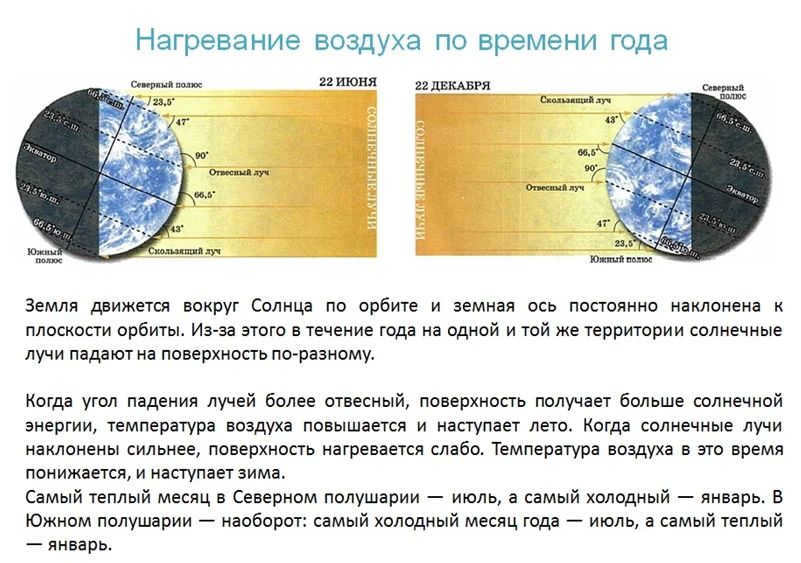
Long-term (30-50 years) records of monthly and yearly air temperature are vital for understanding the climate of a specific region. Weather stations collect air temperature data four times each day: 1 o’clock, 7 o’clock, 13 o’clock, and 19 o’clock. The measurements from the thermometers are combined and divided by four to calculate the average temperature for each day.

In order to calculate the average monthly temperature, you need to sum up the average daily temperatures and then divide the total by the number of days in the month.
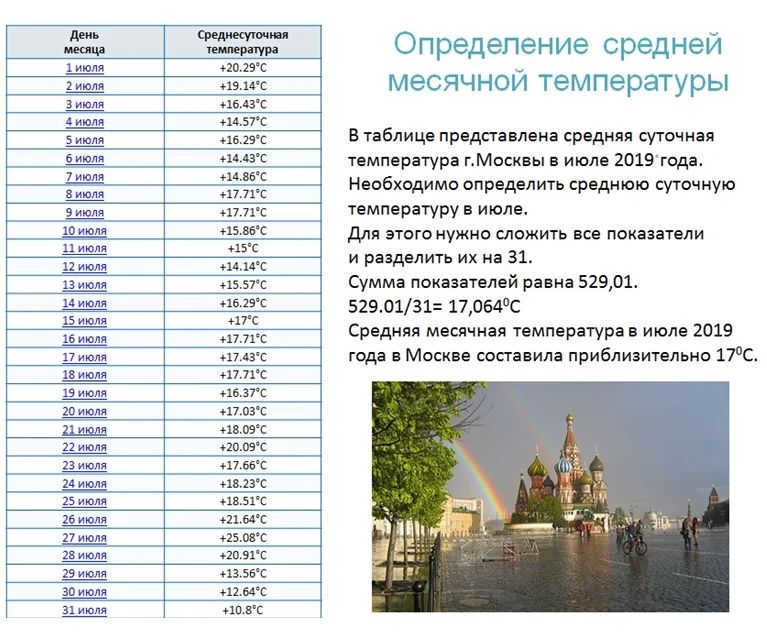
To determine the average annual temperature, you add up the average monthly temperatures and divide the sum by 12.
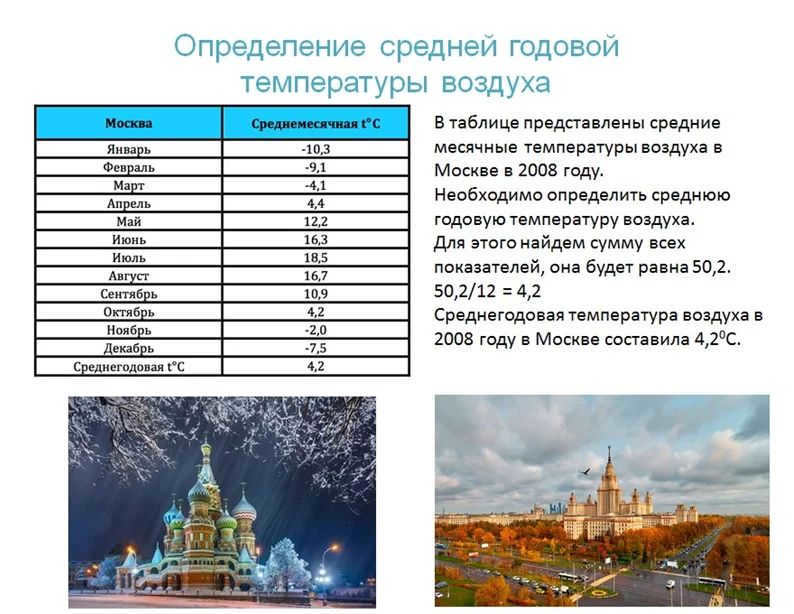
The average temperatures of January and July, which are the coldest and warmest months in the northern hemisphere, hold particular significance in defining the seasons. A crucial factor in this regard is the yearly amplitude of air temperature, which measures the difference between the average temperatures of these two months. Let’s explore how to calculate this temperature amplitude. To do so, let’s refer to the data provided in the previous table which presents the average monthly temperatures in Moscow for the year 2008. The coldest month, January, recorded a temperature of -10.3°C, while the warmest month, July, registered a temperature of 18.5°C. We can determine the difference between these two values to obtain the temperature amplitude.
Consequently, the temperature amplitude for Moscow in 2008 was calculated to be 8.2°C.
The difference between the highest and lowest temperatures yields the daily amplitude.
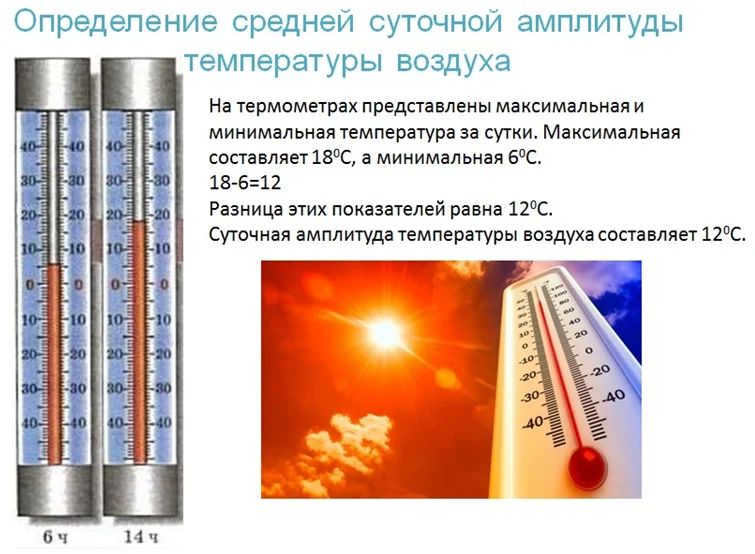
During the summer season, when the weather is clear, the diurnal temperature range is at its highest. Conversely, in cloudy weather, the diurnal temperature range is lower. In areas where there is no continuous vegetation cover, the daily temperature range is greater. This is because the soil, without the presence of vegetation, absorbs and retains more heat during the day, but also cools down more quickly.
The distribution of heat on Earth is visually represented through temperature isotherms. Isotherms are lines that connect locations with similar temperatures during a specific period of time.
As an example, the climate map of Australia depicts the isotherms for the months of January and July. The January isotherm is represented in black and shows a temperature of +30 0 C in the central part of the continent, gradually decreasing to +20 0 C closer to the coast. The July isotherms are marked in red and indicate a temperature of +10 0 C in the southeast and +20 0 C in the northern region.
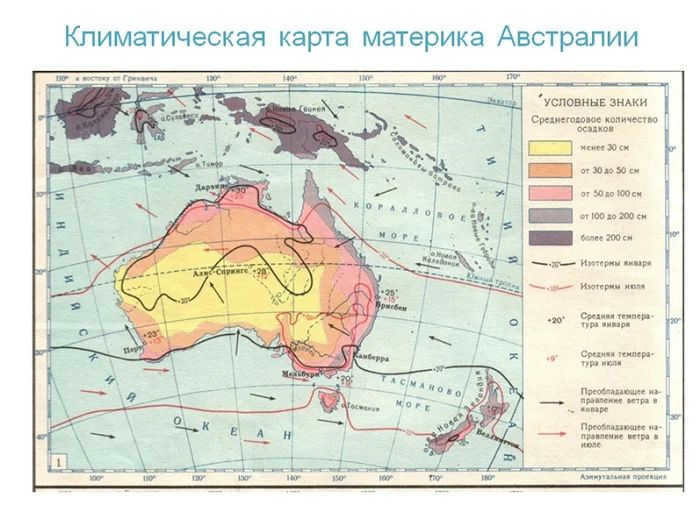
Relationship between Air Temperature and Geographic Latitude
We have already observed that the allocation of solar radiation across the Earth’s surface is influenced by a multitude of factors. The air temperature can fluctuate during the course of a day and throughout the different seasons of the year, and it is further influenced by the geographic latitude of the region.
We can examine the variation in temperature along different latitudes by referring to the map provided below.
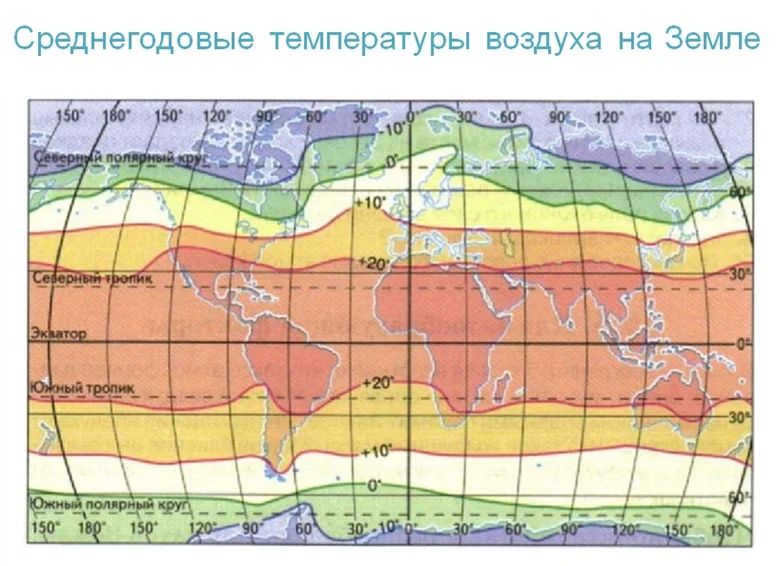
The map clearly illustrates the variation in temperature across different latitudes. As we move from the poles towards the equator, there is a gradual decrease in average annual temperatures. Interestingly, the depicted mean annual isotherms do not align perfectly with the parallels. For instance, the 0°C isotherm extends up to latitude 40°C over land, resulting in the formation of “cold waves”, whereas over the oceans, it surpasses the polar circle, giving rise to “heat waves”. This raises the question of why there are discrepancies in temperatures at the same latitude.
The deviation of isotherms can be attributed to various factors, including different warming and cooling conditions of land and sea, as well as the influence of distinct currents and prevailing winds.
Regardless, there is an evident correlation between temperature and geographic latitude. The equator experiences the highest temperatures, while temperate latitudes typically range from +10°C to -10°C. At the poles, temperatures plummet to -10°C to -40°C.
The distribution of solar radiation across the Earth’s surface is uneven due to its rotation around its axis and the Sun. As a result, there is a variation in air temperature based on latitude. Regions with significant heat input, such as the equator, exhibit high temperatures, while the opposite holds true. Consequently, distinct climatic zones are recognized.
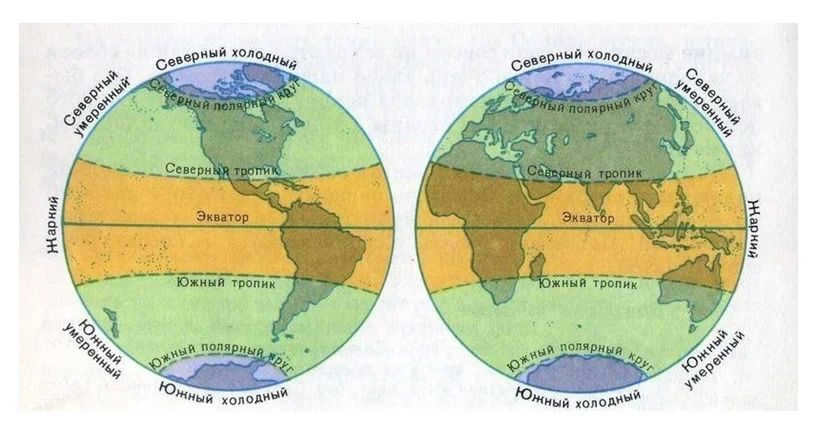
Light zones of the Earth
After carefully examining the map, we can determine how many light zones can be distinguished.
There are seven light zones: hot, two temperate, two cold, and two eternal frost. The boundaries of the light zones follow the parallels.
The hot light zone extends in the equatorial region, encompassing the tropical latitudes. On either side, there are +20°C isotherms.
On both sides of the equator, we can identify temperate light zones. The +20°C isotherm passes through the tropics, while the +10°C isotherm runs through the polar circles.
The cold zones are considered to be the areas beyond the polar circle, located between the +10°C and 0°C isotherms. On land, these zones correspond to the tundra regions.
Each light belt is characterized by a unique temperature regime, which in turn influences the distinct natural conditions found within each belt.
Atmospheric Moisture Levels
Moisture is always present in the atmosphere, frequently in the form of vapor. An interesting phenomenon occurs – when temperatures are high, there is a substantial amount of moisture. So, where does the moisture in the atmosphere originate? The constant evaporation of excess liquid from the ocean and soil takes place, transforming it into vapor. This process is aided by warm weather and wind. The lower part of the air layer becomes saturated with liquid droplets and moves upwards. As the air rises, its temperature decreases, leading to the conversion of vapor into droplets and the occurrence of condensation [1]. Condensation of vapor leads to the creation of clouds, which consist of groups of liquid droplets and crystals. These clouds are small and weightless, causing them to remain in the air instead of falling to the ground. When the air’s humidity increases, the droplets grow in size and eventually fall as precipitation, thus completing the moisture cycle in the atmosphere.
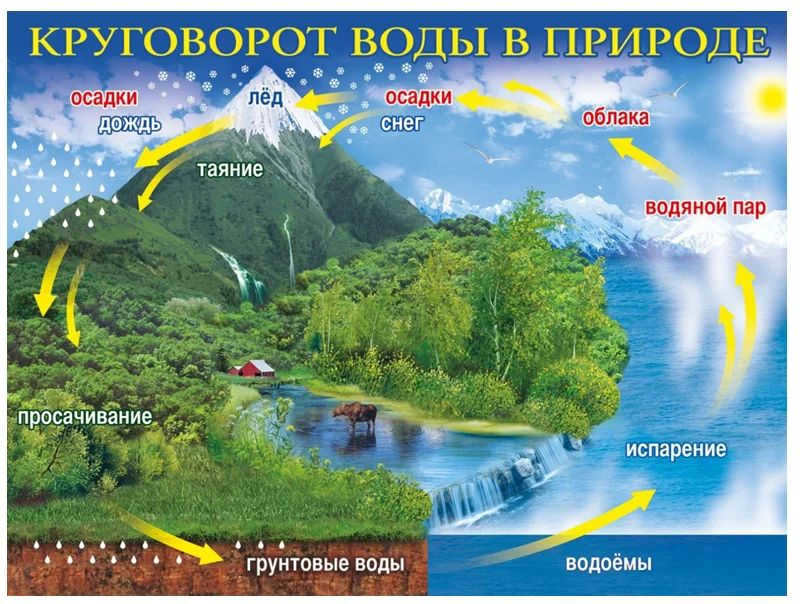
Source
Clouds form in the troposphere, the lower layer of the atmosphere. The atmosphere contains various types of clouds, which can form at different altitudes. As a result, there are several distinct classifications for clouds.
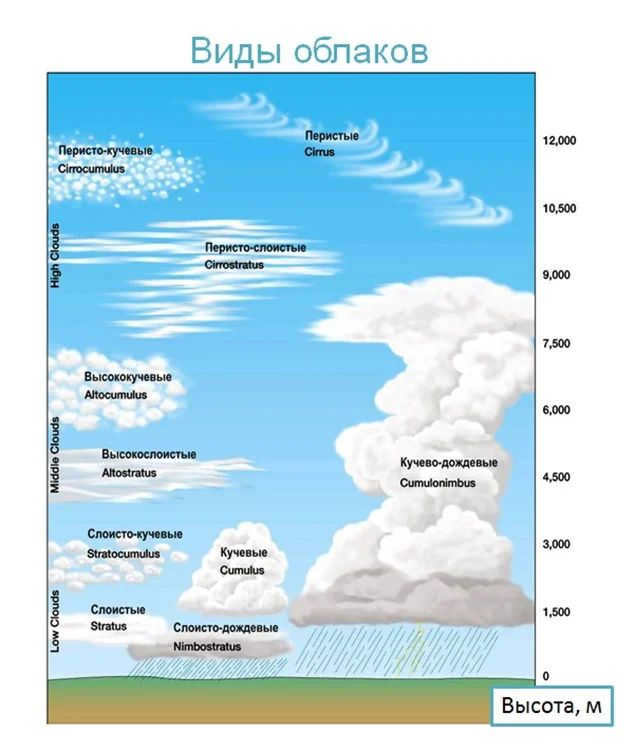
Fog forms when the cooled surface of the earth interacts with the surrounding air. It can also occur when air masses with varying temperatures and humidity mix together. Fog is a phenomenon in the atmosphere where water droplets gather near the surface of the earth.

The presence of fog is often used as an indication of the level of moisture in the air, which can be measured by absolute and relative humidity.
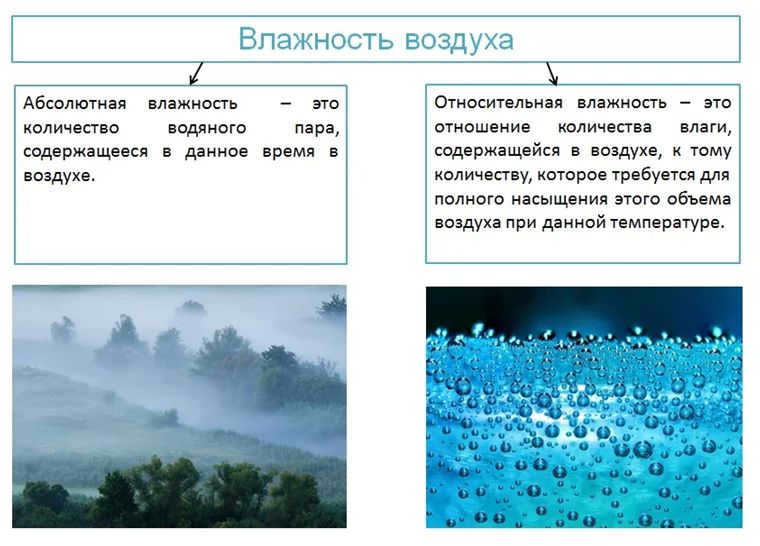
The amount of vapor present in the atmosphere at a given time is known as absolute humidity, which is measured in grams of water per cubic meter of air. During the summer, when temperatures are high, the absolute humidity is at its peak. However, when precipitation occurs, the absolute humidity decreases as some moisture is removed from the atmosphere.
Saturation occurs when the air absorbs all the vapor during a specific period. At this point, the relative humidity of the air becomes relevant.
In the summer, when temperatures are higher, the relative humidity is lower, while in the winter, when conditions are colder, the relative humidity is higher. Precipitation happens after the relative humidity reaches its maximum, causing vapor condensation and a drop in temperature.
Relative humidity is measured using a hygrometer, and there are multiple variations of this device available. The hair hygrometer operates by utilizing the characteristic of human hair to absorb moisture, resulting in a slight increase in hair length. This change in length can be observed on a scale with a movable arrow, which is used to indicate the hygrometer’s reading.


The measurement of air humidity can also be done using a psychrometric hygrometer, which operates on a distinct principle.
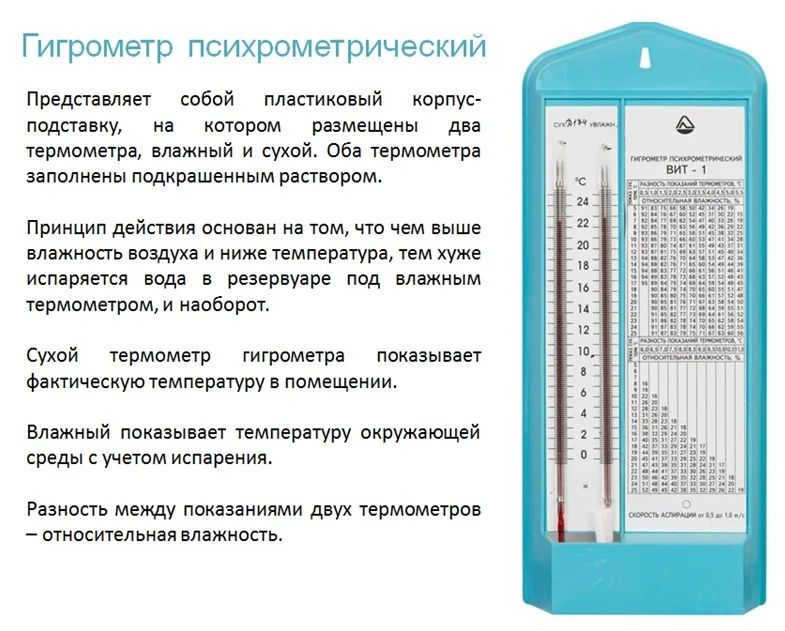
Formation of Atmospheric Precipitation
Precipitation refers to all the moisture that descends to the Earth’s surface.
Now, let’s examine the factors that contribute to the creation of precipitation in the diagram below.
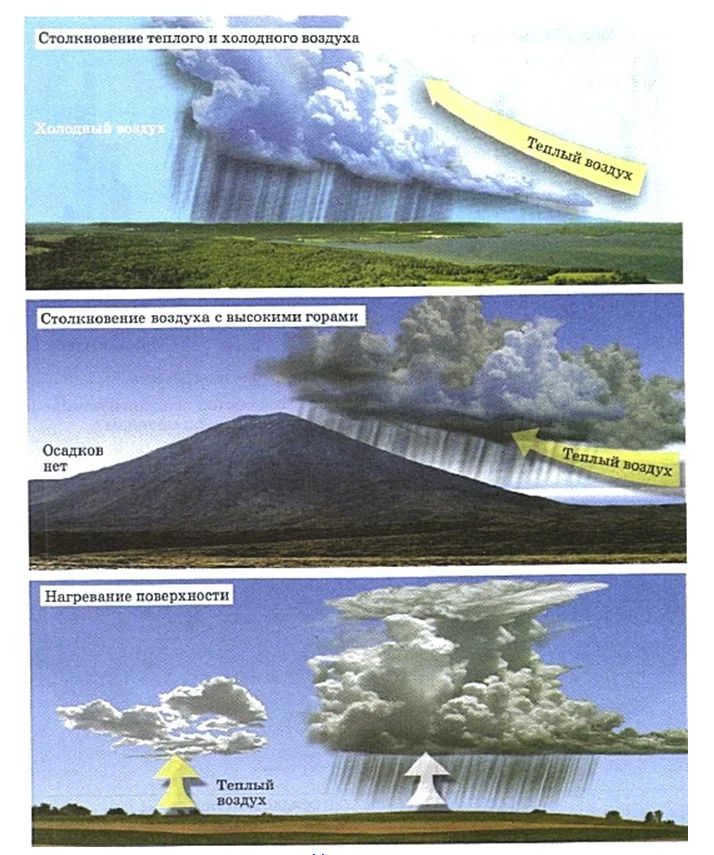
Source
Precipitation comes in various forms.

Clouds are responsible for a significant portion of precipitation. Once the cloud reaches its maximum moisture capacity, it can no longer retain the moisture, resulting in the occurrence of rain.

Rain
In summer, it is possible to witness the phenomenon of hail, which is the result of frozen ice balls falling from the sky. But how exactly are these hailstones formed? It all starts with warm air rising and carrying clouds upwards. As the air ascends, it cools down, and this drop in temperature causes the water droplets within the clouds to freeze. These frozen droplets then clump together and eventually fall to the ground as hailstones, creating a unique form of precipitation.

Hail
During the winter months, one may witness the descent of snowflakes. This form of precipitation plays a crucial part in the growth of cultivated plants. Notably, it serves as a protective shield for winter crops against frost. Moreover, come springtime, it melts into water, which, upon being absorbed by the soil, contributes to the overall moisture levels that plants require.
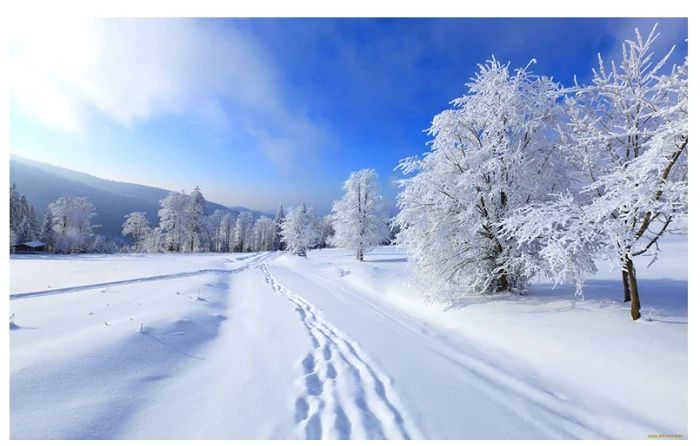
Snow
Anyone can witness the process of rain falling. Have you ever pondered over the origin of the tiny droplets of water that appear on plants in the morning or evening? These droplets, known as “dew”, are actually a form of precipitation that occurs due to the rapid cooling of the ground. The air in close proximity to the surface accumulates enough moisture throughout the day, and the surplus settles on objects during the evening.

Dew
The formation of precipitation such as dew or frost is attributed to the drop in temperature of the ground during the nighttime hours to a level below freezing. During wintertime, one can witness stunning crystal formations on different surfaces, which is also known as frost.

Frost
The earth receives a significant amount of rainfall, which is measured using a device known as a precipitation gauge. This instrument works by measuring the depth of the melted precipitation. A sample is taken over a specific period of time. The Tretyakov gauge is commonly used at meteorological stations. Let’s take a look at this type of precipitation gauge in the image.
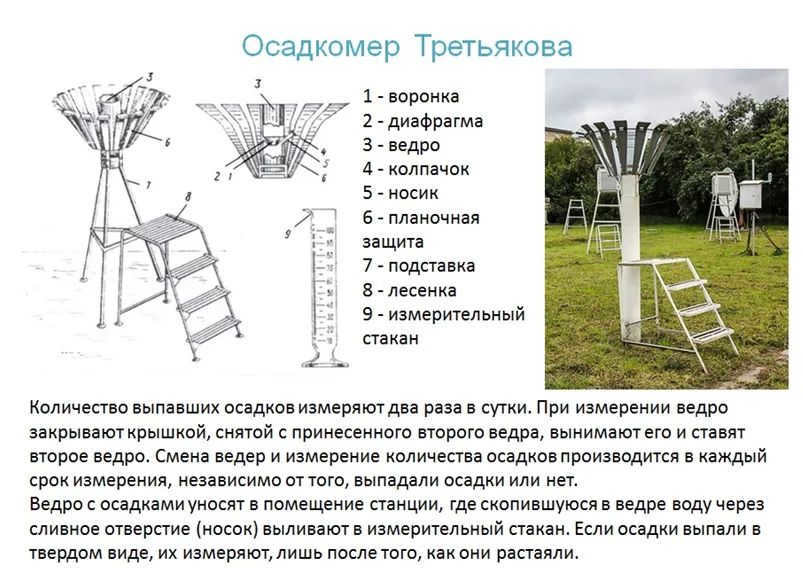
Special diagrams display the distribution of annual precipitation. These diagrams represent the monthly precipitation amounts in the form of bars.
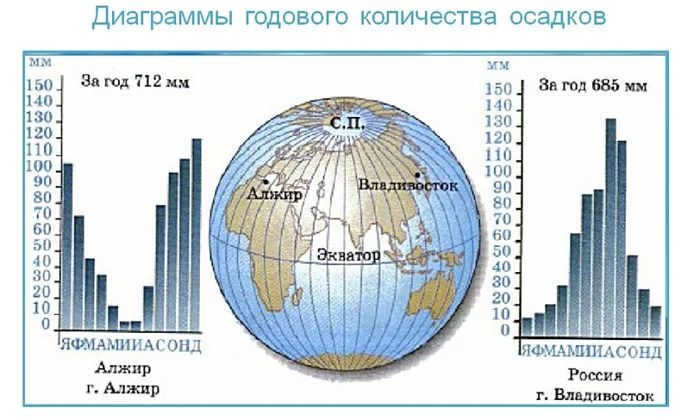
The distribution and amount of precipitation on the Earth’s surface are influenced by various factors, including latitude, prevailing winds, proximity to seas, topography, and warm and cold ocean currents.
Now, let’s examine the specific characteristics of precipitation distribution across the Earth’s surface.
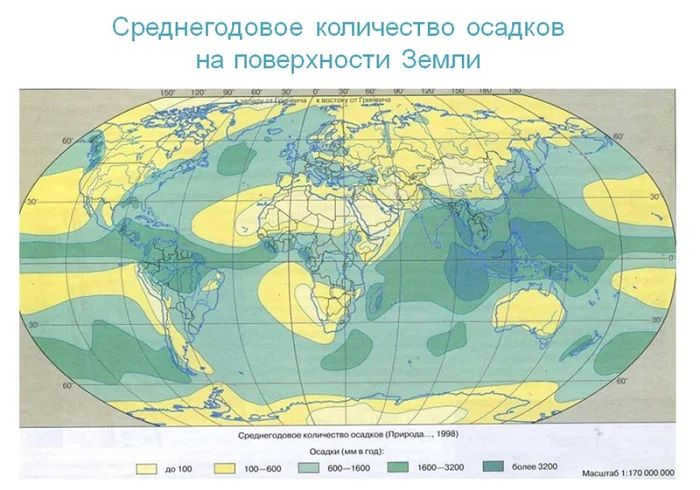
Temperature and precipitation patterns across the Earth’s surface exhibit many similarities. Precipitation levels tend to decrease from the equator towards the poles. The equatorial region experiences the highest amount of precipitation, with over 3000 mm per year. This is primarily a result of the combination of high temperatures and high evaporation rates. The tropical latitudes, on the other hand, are characterized by dry conditions, with less than 200 mm of precipitation. It is in these areas where most deserts are found. The temperate latitudes receive varying amounts of precipitation, ranging from 500 mm to 1000 mm. In the polar regions, precipitation is minimal, with only 100-200 mm per year. This can be attributed to the low temperatures and lack of moisture in these areas.
Vocabulary
Condensation refers to the process of water changing from a gas to a liquid state.
Atmosphere – The gaseous layer surrounding our planet. The formation and modifications in the atmosphere are closely connected to the evolution of Earth. The atmospheric layer is created from the depths of the earth, enriching the soil and water resources with air. The upper limit of the atmosphere marks the boundary with outer space.

Structure of the atmosphere
As previously mentioned, the Earth’s development has directly impacted the formation of its atmospheric layers. Initially, the chemical composition of the atmosphere consisted primarily of helium and hydrogen. However, as the Earth’s surface underwent changes, it interacted with the atmosphere through gas exchange. Various factors such as volcanic eruptions, biological activity, and the water cycle contributed to the introduction of new components into the air.
Nitrogen and oxygen are the primary gaseous elements found in the atmosphere, constituting 99% of its composition. The remaining 1% is composed of helium, argon, neon, methane, hydrogen, carbon dioxide, ozone, ammonia, and other gases. Additionally, the atmosphere contains water vapor and aerosol particles.
The proportion of gases in the atmosphere is traditionally believed to be constant. However, recent research indicates that the level of carbon dioxide is steadily rising. This phenomenon is a direct result of human activities, such as the release of industrial pollutants into the air and deforestation.
The atmosphere plays a crucial role in supporting life on Earth. Oxygen, the primary component of the air envelope, serves as a vital source of sustenance for humans, animals, and plants. Additionally, the atmosphere acts as a shield, absorbing harmful radiation from the Sun, while also trapping heat particles near the Earth’s surface, preventing extreme cold temperatures.
Atmospheric Layers
The atmosphere is composed of multiple layers. These layers include:
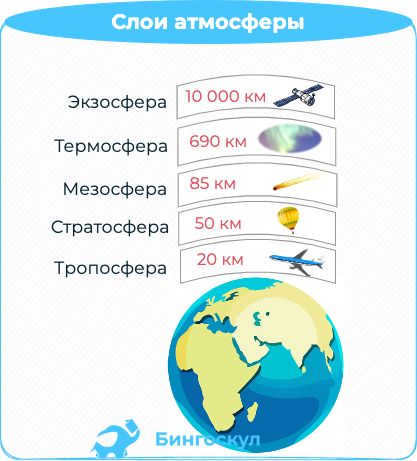
Pollution of the troposphere by man-made gaseous substances leads to alterations in the composition and properties of the envelope.
The tropopause is an intermediate region, a transitional layer between the troposphere and the stratosphere. It is characterized by a decrease in air density and a temperature decrease to -80C.
The second layer of the atmosphere is the stratosphere. In this part of the shell, the temperature increases with altitude, thanks to the abundance of ozone. At 50 km above the surface, the temperature reaches 0C. Water compounds are scarce in the stratosphere, with nacreous clouds being the main representation.
Airflow in this region moves horizontally along the surface of the Earth, which is why airplanes fly in the stratosphere.
The stratopause serves as the boundary between the stratosphere and the mesosphere.
The mesosphere is located between 50-80 kilometers above the Earth’s surface. In this layer, temperatures sharply decrease to a range of 90 to 130 degrees. It is here that meteorite particles combust, giving rise to the phenomenon of meteors.
The subsequent layers of the atmosphere, the thermosphere and the exosphere, act as transitional zones to outer space and have very little air. These layers are where Earth satellites orbit, with the limit being at an altitude of 3000 km.
Formation of Climate and Weather
The formation of climate and weather patterns is influenced by changes in the atmosphere and its properties:
- The inclination of the sun’s rays determines the temperature distribution on the Earth’s surface. A smaller angle of inclination leads to higher temperatures, as observed in the climatic zones near the equator.
- Air currents are formed as a result of the heating of the Earth’s surface, ranging from local winds to trade winds and monsoons.
- Climate formation is also influenced by atmospheric pressure. Air masses move from regions of high pressure (polar latitudes) to regions of low pressure (equator). Changes in atmospheric pressure are closely related to changes in air temperature. An increase in atmospheric pressure can negatively impact human well-being.
- The occurrence of precipitation is influenced by factors such as temperature, air circulation, and topography. Precipitation is not evenly distributed and varies across different climatic zones.
The aforementioned studies contribute to our understanding of the relationship between the atmosphere, climate, and weather.
Weather forecasting involves analyzing the current and past atmospheric conditions to make predictions about future changes, as the atmosphere plays a significant role in shaping the weather. The collective weather patterns in a specific location determine its climate.
Further reading:
Learn about the origins, composition, and fascinating details of our planet

The Composition and Characteristics of Earth’s Atmosphere. The planet Earth stands alone in our solar system as the only one with a life-supporting atmosphere.
Comprised of a blend of gases, Earth’s atmosphere envelops the planet, providing essential benefits such as oxygen for breathing and shielding us from the sun’s damaging ultraviolet rays. Furthermore, it plays a crucial role in warming the Earth’s surface by approximately 33°C due to the greenhouse effect, and it also helps regulate temperature variations between day and night, preventing extreme fluctuations.

The thickness of the Earth’s atmosphere measures approximately 480 kilometers, with the majority of it being concentrated within 16 km of the planet’s surface. As one ascends in altitude, air pressure gradually decreases. At sea level, the air pressure is roughly equivalent to 1 kilogram per square centimeter. However, at an elevation of 3 km, the air pressure drops to around 0.7 kg per square centimeter. Additionally, the oxygen levels become diminished at higher altitudes, making it more difficult to breathe.
The composition of the Earth’s atmosphere. The Earth’s atmosphere is a delicate blend of gases that envelops our planet. It is made up of primarily nitrogen, which accounts for about 78% of the atmosphere. Oxygen is the second most abundant gas, comprising roughly 21% of the atmosphere. Argon makes up a smaller portion, around 0.9%. Carbon dioxide, although present in only trace amounts (about 0.03%), plays a crucial role in regulating the Earth’s temperature. Additionally, there are other gases present in the atmosphere, each accounting for less than 1% of the total mixture. Furthermore, the atmosphere contains varying amounts of water vapor, which averages out to about 1% overall. Lastly, the atmosphere is not just composed of gases and water vapor, but also contains numerous tiny particles known as aerosols. These aerosols include dust, spores, pollen, salt from sea spray, volcanic ash, smoke, and other microscopic entities.
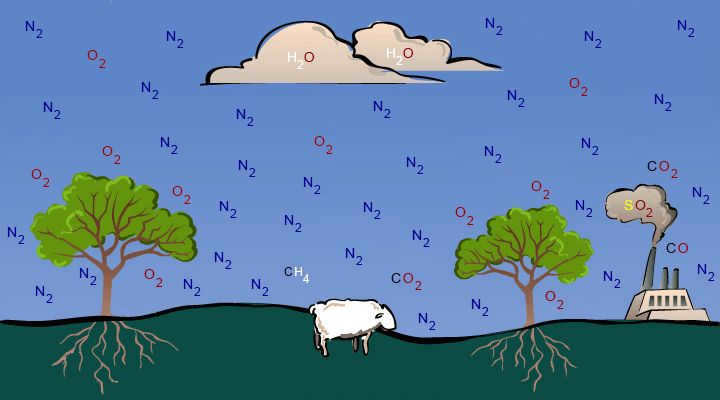
The different layers of Earth’s atmosphere are as follows:
- The first layer is called the troposphere. This layer is closest to the Earth’s surface and is where weather occurs. It contains most of the Earth’s air mass and is characterized by decreasing temperature with increasing altitude.
- Above the troposphere is the stratosphere. This layer contains the ozone layer, which absorbs the majority of the Sun’s ultraviolet radiation. The temperature in the stratosphere increases with altitude.
- Next is the mesosphere, which is the third layer of the atmosphere. In this layer, temperatures decrease with altitude.
- Above the mesosphere is the thermosphere. This layer is characterized by very high temperatures due to the absorption of solar radiation. It is also where the Northern and Southern Lights occur.
- The outermost layer of the Earth’s atmosphere is the exosphere. This layer gradually transitions into interplanetary space. The exosphere is very sparse and contains mostly hydrogen and helium.
While there is no definitive boundary between the atmosphere and space, scientists generally consider the Karman line to be where the atmosphere ends and space begins. This imaginary line is usually located between 100 and 120 kilometers above the Earth’s surface. However, even above this line, there are still traces of atmospheric gases that can be measured hundreds of kilometers above the Earth.
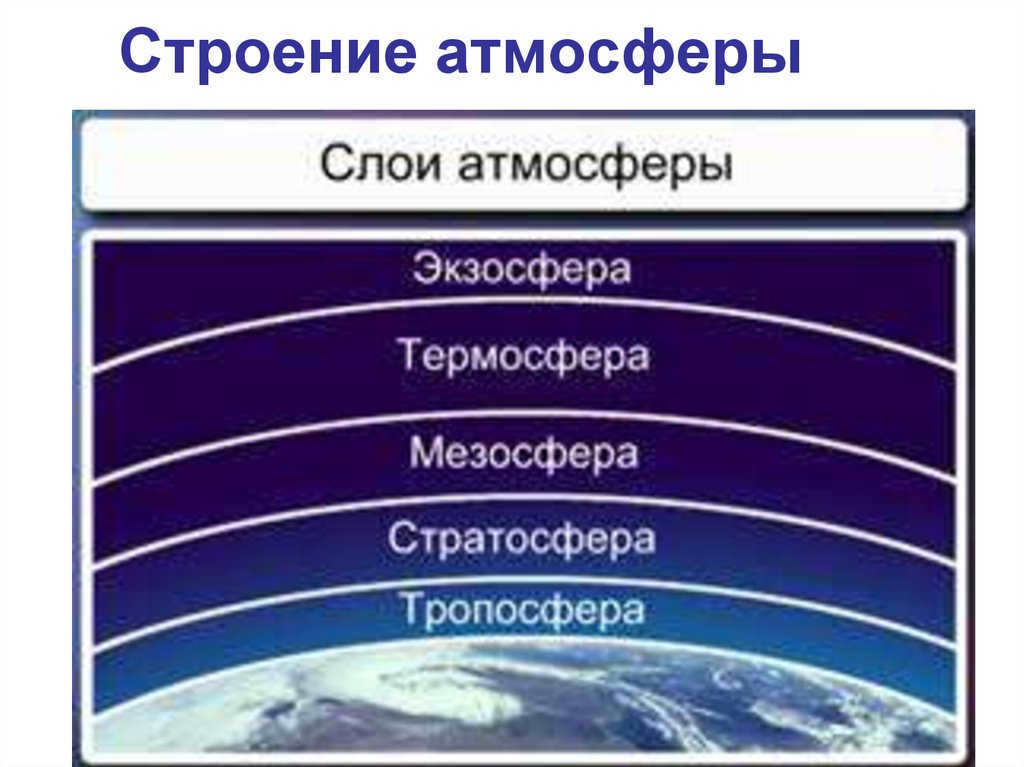

The troposphere is the lowest layer of Earth’s atmosphere
The troposphere represents the bottommost layer of the Earth’s atmosphere. It stretches approximately 10 kilometers above the sea level, starting from the ground. Humans inhabit the troposphere, and nearly all weather phenomena originate within this lower layer. The majority of clouds form here, primarily due to the fact that 99% of the atmospheric water vapor is concentrated in the troposphere. This layer is significantly more humid compared to the layers above, which contain minimal moisture. As one ascends through the troposphere, both air pressure and temperature decrease.
The height of the troposphere layer varies depending on the latitude (it is lowest at the poles and highest at the equator) and the season (it is lower in winter and higher in summer). It can reach up to 20 km near the equator and only 7 km above the poles during winter.
The temperature of the air is highest at ground level and decreases as you ascend through the troposphere. This is why even in summer, the peaks of tall mountains can be covered in snow.
As altitude increases, air pressure and density also decrease. That is why in the cockpits of high-flying jet airplanes, it is necessary to artificially increase the pressure compared to the external pressure.
The layer directly above the troposphere is known as the stratosphere. The boundary between the troposphere and the stratosphere is called the “tropopause”.
The stratosphere is the penultimate layer of Earth’s atmosphere. Just below the stratosphere lies the troposphere, the lowest layer. Above the stratosphere is the mesosphere.
At mid-latitudes, the bottom of the stratosphere is located 10 kilometers above the surface of the Earth. The upper boundary of the stratosphere reaches an altitude of 50 km. The height of the lower boundary of the stratosphere can vary depending on the latitude and time of year, reaching 20 km near the equator and only 7 km at the poles during winter. The lower boundary of the stratosphere is known as the tropopause, while the upper boundary is referred to as the stratopause.
The stratosphere contains a significant amount of ozone, which is a unique type of oxygen molecule. This ozone plays a role in heating the stratosphere by absorbing the ultraviolet radiation from the Sun. Unlike in the troposphere, where the temperature decreases as you go higher, the temperature in the stratosphere actually increases with altitude. This temperature variation creates a stable environment with minimal convection and mixing. As a result, commercial airplanes prefer to fly in the lower stratosphere to avoid the turbulence that is often found in the lower layer known as the troposphere.
The stratosphere is characterized by a lack of moisture, resulting in a scarcity of clouds in this region. The majority of clouds are found in the lower troposphere, which has higher levels of humidity. However, there is an exception to this pattern known as polar stratospheric clouds (PSCs). PSCs occur in the lower stratosphere near the poles during the winter season. These clouds form at altitudes ranging from 15 to 25 km and are only observed when temperatures at these heights drop below -78 °C. Interestingly, PSCs are believed to play a role in the depletion of the ozone layer by promoting specific chemical reactions that lead to its destruction. These clouds are also referred to as nacreous clouds.

The atmosphere at the uppermost part of the stratosphere is significantly less dense compared to sea level. As a result, the stratosphere is the optimal altitude for jet airplanes and weather probes to operate at their highest levels.
Due to the absence of vertical convection in the stratosphere, substances that enter this layer can remain there for extended periods. This is particularly true for chlorofluorocarbons (CFCs), which are chemicals known to deplete ozone.
Chlorofluorocarbons (CFCs) are chemical compounds comprised of carbon, chlorine, and fluorine atoms. They are utilized in the manufacturing of aerosol cans, foaming agents, packaging materials, solvents, and refrigerants.
In the stratosphere, there exists a unique form of electrical discharge that bears some resemblance to lightning. Referred to as “blue jets”, these intriguing phenomena manifest themselves above thunderstorms and stretch from the lower stratosphere all the way up to altitudes of 40 to 50 km.

Mesosphere. Information
The mesosphere occupies the region above the stratosphere and below the thermosphere. It covers a height range of approximately 50 to 85 km above our planet.
As one ascends through the mesosphere, temperatures progressively decrease. The lowest temperatures in the Earth’s atmosphere, which reach around -90 °C, can be found at the uppermost part of this layer.
The point where the mesosphere transitions into the thermosphere is known as the mesopause. Situated at the lower boundary of the mesosphere is the stratopause.
The mesosphere is a challenging area to investigate, resulting in less information being available compared to other atmospheric layers. Due to its high altitude, meteosondes and aircraft are unable to reach the mesosphere. Satellites, which orbit above this layer, also face limitations in directly studying it. To overcome these challenges, scientists employ a range of instruments on sounding rockets for direct exploration of the mesosphere. However, due to the short and infrequent nature of these flights, our understanding of the mesosphere remains incomplete. The difficulty in directly measuring this layer with instruments contributes to the unresolved aspects of the mesosphere.
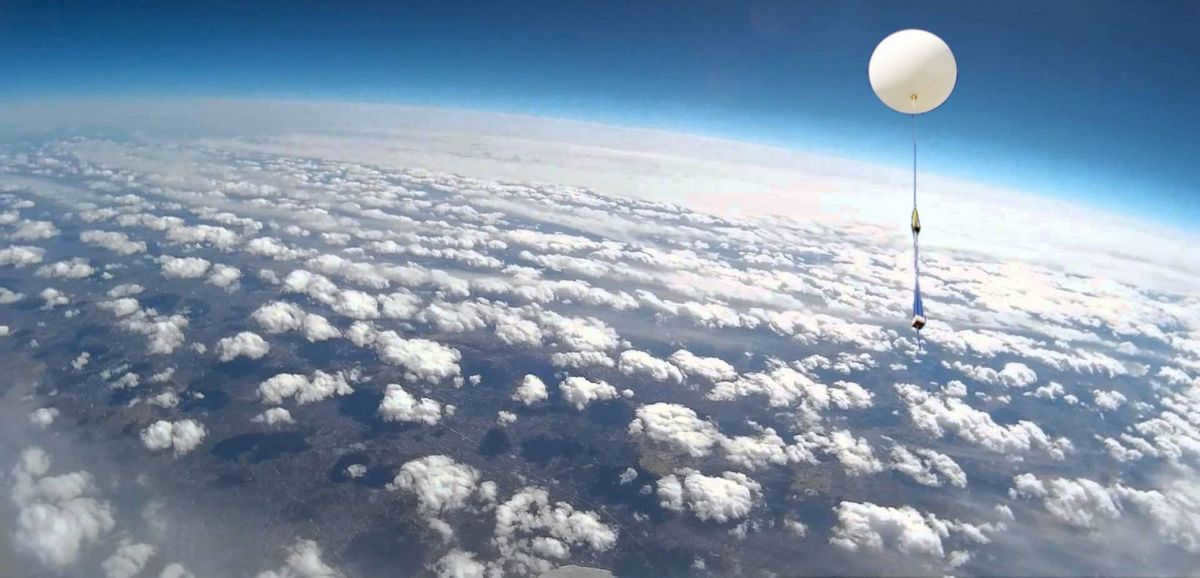
The majority of meteors burn up in the mesosphere. Some meteoric material becomes trapped in the mesosphere, resulting in a higher concentration of iron and other metal atoms in this layer.
Unusual clouds, known as “silver clouds” or “polar mesospheric clouds,” occasionally form in the mesosphere near the poles. These unique clouds form at much higher altitudes than other cloud types. The mesosphere, similar to the stratosphere beneath it, is significantly drier than the humid troposphere we inhabit, making cloud formation in this layer quite surprising.
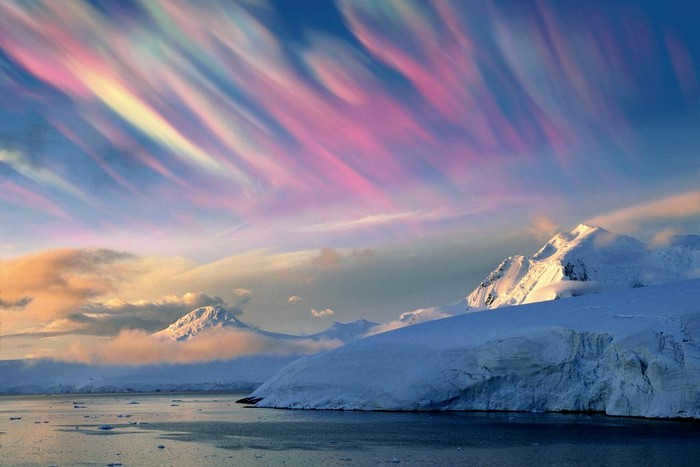

Occasionally, the mesosphere generates peculiar electrical discharges resembling lightning, known as “sprites” and “elves,” at altitudes of tens of kilometers above thunderclouds in the troposphere.
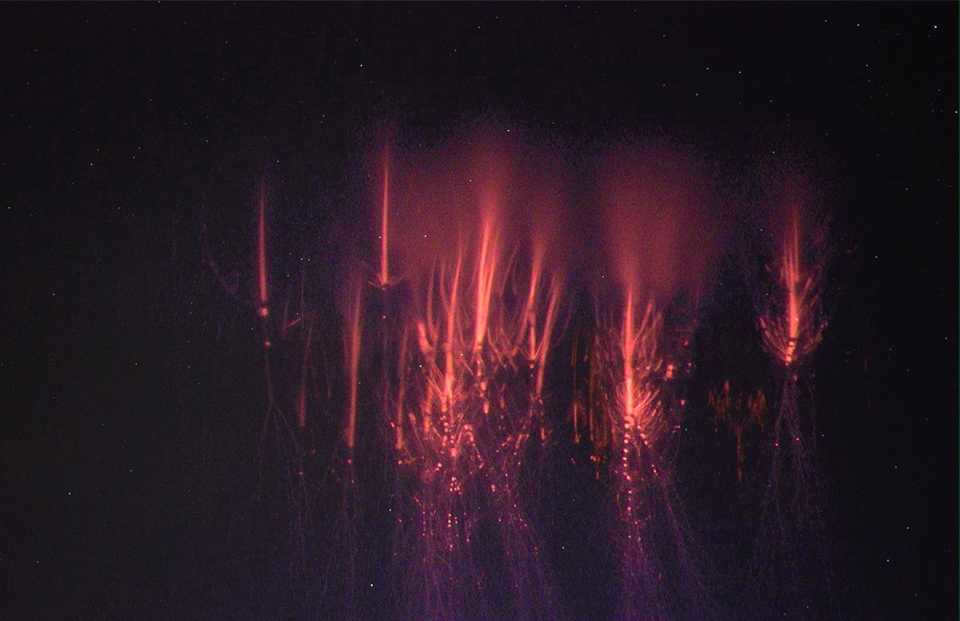
The stratosphere and mesosphere are occasionally referred to as the middle atmosphere.
Thermosphere. Characteristics
The thermosphere is the region of Earth’s atmosphere that is situated directly above the mesosphere and below the exosphere. It spans from 90 km to 500-1000 km above our planet.
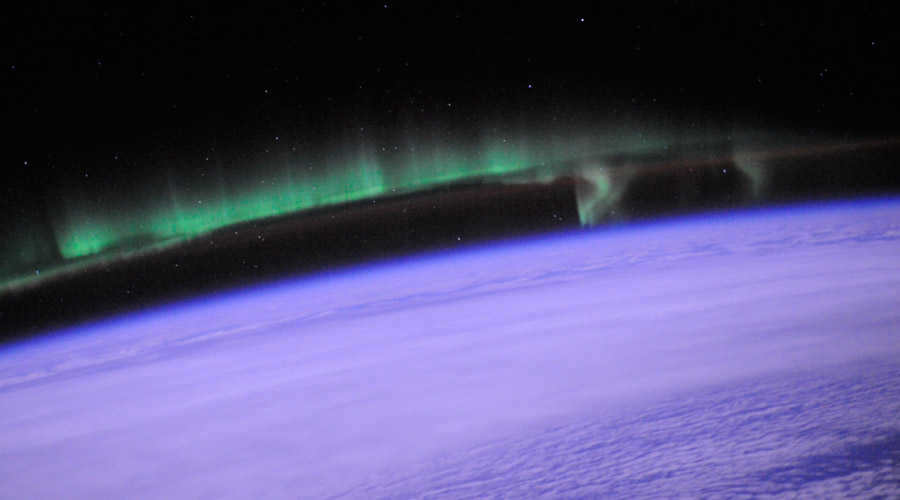
In the lower thermosphere (200-300 km above sea level), the temperature experiences a rapid increase, followed by a leveling off and a relatively stable state as altitude increases. The temperature in the thermosphere is heavily influenced by solar activity. During the day, the thermosphere is typically about 200 °C hotter than at night, and during periods of increased solar activity, it can be around 500 °C hotter. In the upper thermosphere, temperatures can reach as high as 2000 °C or even higher.
The boundary between the thermosphere and the exosphere above it is known as the thermopause. At the lower boundary of the thermosphere lies the mesopause.

Under the thermosphere, the atmosphere contains a mixture of different types of atoms and molecules that are mixed together by turbulence. The lower atmosphere is predominantly made up of a well-known combination of 80% nitrogen molecules (N2) and 20% oxygen molecules (O2). As we move into the thermosphere and beyond, gas particles collide so infrequently that the gas molecules transform into individual atoms. In the upper thermosphere, the primary components of the air are atomic oxygen (O), atomic nitrogen (N), and helium (He).
Most of the X-ray and ultraviolet radiation emitted by the Sun is absorbed in the thermosphere. When the Sun becomes more active and releases additional energy, the thermosphere warms up and expands. As a result, the height of the thermopause, which marks the upper boundary of the thermosphere, changes. The thermopause typically ranges between 500 and 1000 kilometers in altitude, occasionally reaching even higher levels. Since numerous satellites orbit within the thermosphere, the fluctuations in air density at orbital altitudes caused by the thermosphere’s heating and expansion generate a frictional force that affects the satellites’ rotation. Engineers must consider this variable drag when calculating orbital paths, and sometimes satellites need to be elevated to higher altitudes in order to compensate for the influence of drag forces.
When high-energy solar photons interact with gas particles in the thermosphere, they have the ability to remove electrons, resulting in the formation of electrically charged ions. These ions are made up of atoms and molecules. The ionosphere of the Earth is located within the thermosphere and consists of various regions that contain these ionized particles. It is important to note that the thermosphere itself is electrically neutral.
Similar to the oceans, the Earth’s atmosphere also experiences waves and tides. These atmospheric waves and tides are responsible for transporting energy, including within the thermosphere. The movement of these waves and tides largely influences the winds and general circulation patterns within the thermosphere. In certain areas of the thermosphere, collisions between moving ions and electrically neutral gases can generate powerful electric currents.
Ultimately, the majority of polar lights, also known as southern and northern lights, are predominantly located in the thermosphere. In the thermosphere, charged particles like electrons, protons, and other ions from outer space interact with atoms and molecules. This interaction occurs primarily at high latitudes, causing the atoms and molecules to enter higher energy states. Subsequently, these energized atoms and molecules release the surplus energy by emitting photons of light, which manifest as vibrant and colorful auroras.
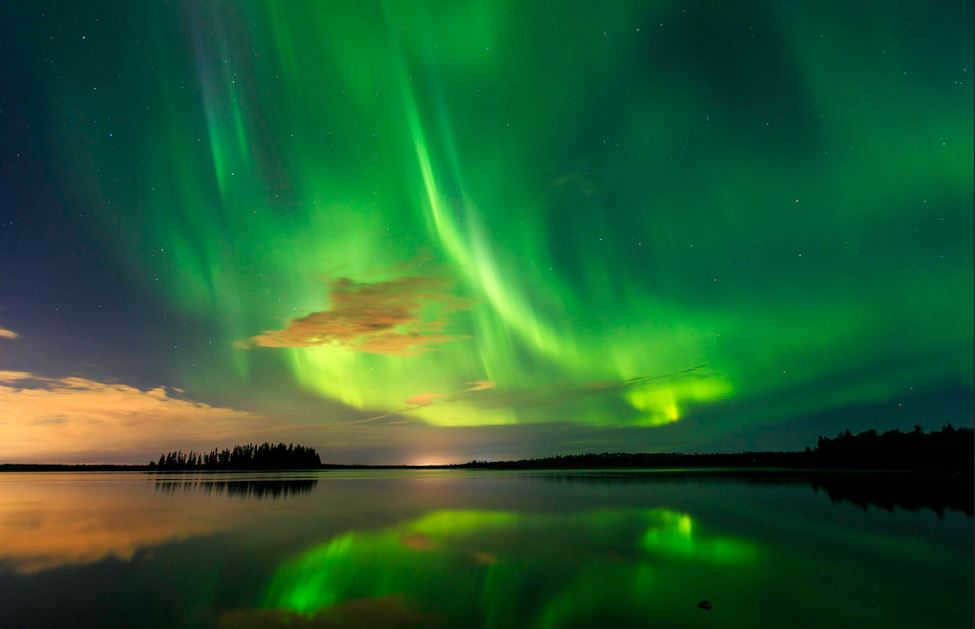
Exosphere. Characteristics
The exosphere represents the highest section of Earth’s atmosphere as it gradually dissipates into the vastness of outer space. The atmosphere in the exosphere is incredibly sparse – in many aspects, it closely resembles the airless void found in the cosmos.
The lower boundary of the exosphere, which separates it from the thermosphere, is referred to as the thermopause or sometimes known as the exobase. The altitude at which the lower boundary of the exosphere is located can vary. During periods of increased solar activity, such as the presence of sunspots on the Sun, the Sun’s X-ray and ultraviolet radiation cause the thermosphere to heat up and become more pressurized, resulting in the thermopause reaching heights of approximately 1000 km above the Earth’s surface. Conversely, when the Sun is less active, the intensity of solar radiation decreases, causing the thermopause to descend to around 500 km above the Earth’s surface.
There is disagreement among scientists regarding whether the exosphere should be classified as part of the atmosphere. Certain scientists argue that the thermosphere is the highest region of the Earth’s atmosphere and assert that the exosphere is effectively part of outer space. Conversely, other scientists maintain that the exosphere should indeed be recognized as a component of our planet’s atmosphere.
As the exosphere gradually dissipates into the vastness of space, there exists no definitive boundary for this layer. According to one interpretation of the outermost extent of the exosphere, the highest point of Earth’s atmosphere is approximately 190,000 kilometers away, roughly halfway to the Moon. At such a distance, the radiation pressure exerted by sunlight has a more pronounced impact on hydrogen atoms than the gravitational pull of our planet. Satellites have observed a faint emission of ultraviolet radiation, caused by the scattering of hydrogen atoms in the uppermost atmosphere, at an altitude of 100,000 km. This zone of ultraviolet emission is referred to as the geocorona.
Below the exosphere, the collision of molecules and atoms of atmospheric gases is a constant occurrence. However, due to the extreme rarity of air in the exosphere, such collisions are exceptionally infrequent. The movement of gas atoms and molecules in the exosphere follows a path similar to that of a thrown ball or a fired cannonball, known as a “ballistic trajectory,” in which the trajectory gradually curves back toward Earth under the influence of gravity. The majority of gas particles in the exosphere travel along curved trajectories, never encountering another atom or molecule, and eventually return to the lower atmosphere as a result of gravity. Nevertheless, a fraction of the faster-moving particles do not return to Earth; instead, they venture off into outer space. Consequently, a small portion of our atmosphere manages to “escape” into space each year.





